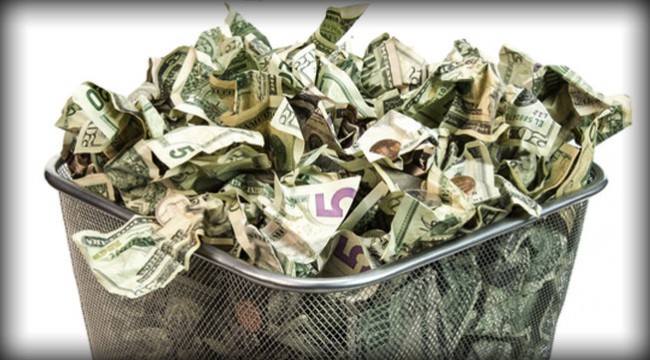Infrastructure Spending and Helicopter Money: Two Hideous Ideas
The key to restoring Main Street prosperity is not launching an infrastructure financing bank as the Beltway bandits keep insisting and even Donald Trump has advocated.
That will result in waste of capital, malinvestments, reduced economic efficiency and an even more bloated public sector than we already have. The bank that needs addressing, in fact, is the nation’s central bank.
Until the Fed’s massive intrusion in financial markets is eliminated via abolishing the Federal Open Market Committee and government-debt purchases, there is virtually no prospect of reigniting capitalist vigor and growth in the United States.
What that means, therefore, is that a half-trillion-dollar infrastructure spree like the one The Donald pulled out from under his comb-over represents a very dangerous idea. It would add measurably to the $35 trillion of public debt that is already baked into the cake, and put the politicians of the Imperial City knee-deep in the distribution of prodigious amounts of pork barrel.
In fact, they desperately need to get on with the opposite — a painful process of fiscal retrenchment that is unavoidable if national bankruptcy is to be prevented. Worse still, adding to the nation’s monumental debt pile in the face of nominal GDP growth that is stuck under the 3% barrier would be nearly suicidal.
It would raise the ratio of public debt to national income — which is already on a path toward 150% — to even more crushing levels. At the end of the day, Donald Trump knows a lot about debt, and its dangers when it gets out of hand, and almost nothing about the economics of growth and public infrastructure. He should be sounding the alarm about the former.
The public infrastructure crusade, by contrast, is just another Beltway boondoggle of the kind that he has loudly condemned and which have already brought Flyover America to the brink of ruin.
Nor is so-called helicopter money any kind of answer.
“Helicopter money” isn’t some kind of new wrinkle in monetary policy, at all. It’s an old-as-the-hills rationalization for monetization of the public debt — that is, purchase of government bonds with central bank credit conjured from thin air.
It’s the ultimate in “something for nothing” economics. That’s because those government bonds originally funded the purchase of real economic resources such as labor hours, contract services or dams and aircraft carriers. As a technical matter, helicopter money is exactly the same thing as QE.
But that’s not the real reason why helicopter money policy is so loathsome. The unstated essence of it is that our monetary politburo would overtly conspire and coordinate with the White House and Capitol Hill to bury future generations in crushing public debts.
They would do this by agreeing to generate incremental fiscal deficits — as if Uncle Sam’s current $19 trillion isn’t enough debt — which would be matched dollar for dollar by an increase in the Fed’s bond-buying, or monetization rate. That amounts not only to teaching children how to play with matches; it’s tantamount to setting fiscal forest fires across the land.
There are a few additional meaningless bells and whistles to the theory, but its essential crime against democracy and economic rationality should be made very explicit. It would amount to a central bank power grab like no other because it insinuates our unelected central bankers into the very heart of the fiscal process. Needless to say, the framers delegated the powers of the purse — spending, taxing and borrowing — to the elected branch of government, and not because they were wild-eyed idealists smitten by a naïve faith in the prudence of the demos.
To the contrary, they did so because the decision to spend, tax and borrow is the very essence of state power. There is no possibility of democracy — for better or worse — if these fundamental powers are removed from popular control. Yet that’s exactly what helicopter money policy would do. Based on Keynesian gobbledygook about the purported gap between full-employment or “potential GDP” and actual output and employment, the FOMC would essentially set a target for the federal deficit.
At one level, of course, it is to be expected that the people’s elected representatives would relish this “expert” cover for ever-bigger deficits and the opportunity to wallow in the pork barrel allocation of the targeted tax cuts and spending increases.
There is surely not a single hard-core New Dealer turning in his grave who could have imagined a better scheme for priming the pump. Yet helicopter money turns the inherently dangerous idea of fiscal borrowing in a democracy into an outright monetary fraud, and that prospect is sure to kindle vestigial fears of the public debt even among today’s politicians
At the end of the day, “helicopter money” is just a desperate scam emanating from the world’s tiny fraternity of central bankers who have walked the financial system to the brink, and are now trying to con the casino into believing they have one more magic rabbit to pull out of the hat.
They don’t. That’s because helicopter money will not pass the laugh test even in the Imperial City, and, more importantly, because it takes two branches of the state to tango in the process of implementation. Unlike ZIRP and QE, helicopter money requires the peoples’ elected representatives to play, and to do so on an expedited basis.
Congress and the White House must generate large incremental expansions of the fiscal deficit — so that the central bankers can buy it directly from the U.S. Treasury, and then credit the government’s accounts at the Federal Reserve with funds conjured from thin air.
But this assumes there is still a functioning government in Washington and that politicians have been 100% cured of their lingering fears of the public debt. But what is going to cause helicopter money to be a giant dud — at least in the U.S. — is that neither of these conditions are extant.
Regardless of whether the November winner is Hillary or The Donald, there is one thing certain. There will be no functioning government come 2017. Washington will be the site of a political brawl of deafening and paralyzing aspect — like none in U.S. history, or ever.
The reality of rapidly swelling deficits even before enactment of a massive helicopter money fiscal stimulus program will scare the wits out of conservative politicians, and much of the electorate, too.
What fools like Bernanke haven’t reckoned with is that sheer common sense has not yet been driven from the land. In fact, outside of the groupthink of a few dozen Keynesian academics and central bankers, the very idea of helicopter money strikes most sensible people as preposterous, offensive and scary.
Even if Wall Street talks it up, there will be massive, heated, extended and paralyzing debate in Congress and the White House about it for months on end. There is virtually no chance that anything that even remotely resembles the Bernanke version of helicopter money could be enacted into law and become effective before 2018.
If Trump is elected the fiscal process will lapse into confrontation and paralysis for an indefinite spell. And if Hillary is elected, the Republican House will become a killing field for almost anything she proposes, and most especially the rank Keynesian apostasy of outright and massive debt monetization.
Yet absent a massive new round of monetary juice like helicopter money, the stock market will not be able to avoid its Wile E. Coyote moment.
Regards,
David Stockman
for The Daily Reckoning
Ed. Note: The most entertaining and informative 15-minute read of your day. That describes the free daily email edition of The Daily Reckoning. It breaks down the complex worlds of finance, politics and culture to bring you cutting-edge analysis of the day’s most important events. In a way you’re sure to find entertaining… even risqué at times. Click here now to sign up for FREE.



Comments: